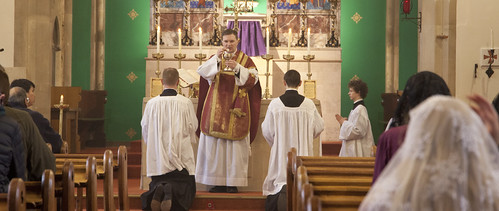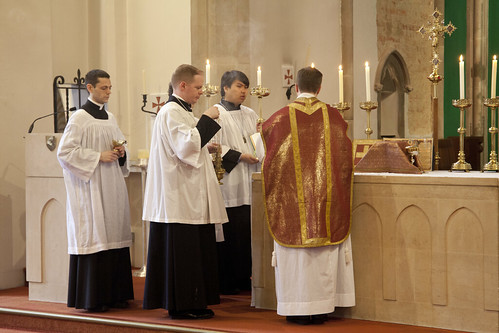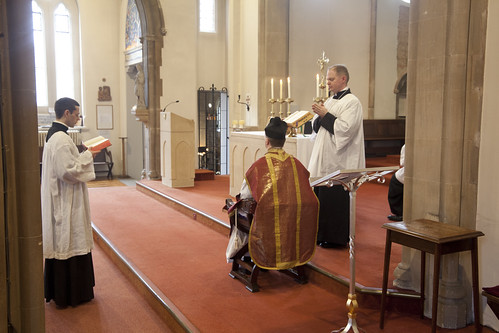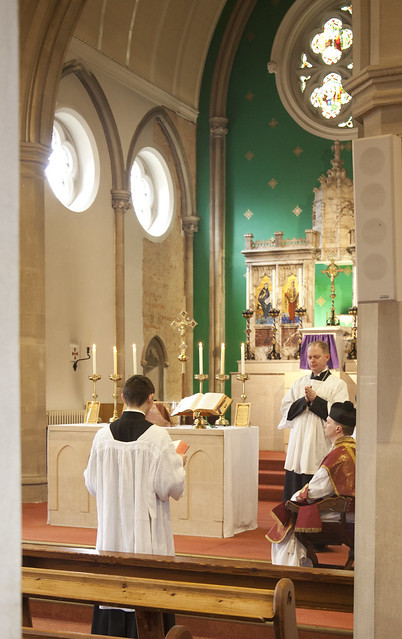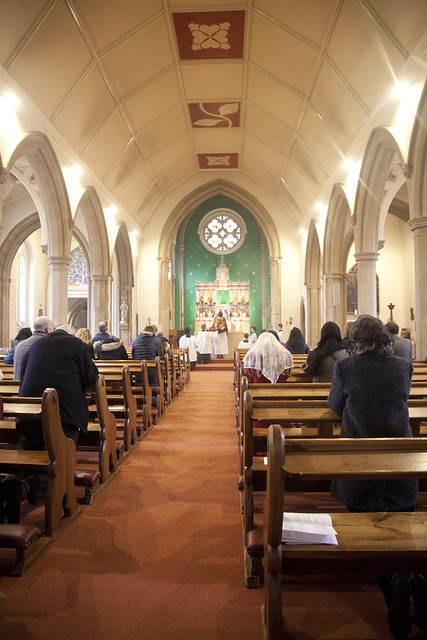Chairman's Blog
Rigid Catholics: a talk in London
 And I ask myself: Why so much rigidity? Dig, dig, this rigidity always hides something, insecurity or even something else. Rigidity is defensive. True love is not rigid.
And I ask myself: Why so much rigidity? Dig, dig, this rigidity always hides something, insecurity or even something else. Rigidity is defensive. True love is not rigid.I shall be giving a talk, 'Why do they call you rigid?', in London on Friday.
It is part of the Iota Unum series, and will take place at 7:30pm in the basement of Our Lady of the Assumption, Warwick Street, on Friday 26th (Easter Friday).
Access via the basement steps from Golden Square (map).
£5 on the door; drinks provided.
I shall be discussing the development of the notion of psychological rigidity from the 1930s, the way the theory has been used, problems with the theory, its relationship with the Catholic faith, and how one can respond when accused of rigidity.
What were Catholic schools like in the Bad Old Days?
A friend of mine found a school Religious Instruction curriculum dating from ther 1930s or '40s in the Diocese Clifton, and I've written a LifeSiteNews article about it.
Here's a quote.
Support the Latin Mass Society
London Easter Triduum: World premier of Peter Kwasniewski tenebrae compositions
PRESS RELEASE from the Latin Mass Society
This Holy Week in the heart of London, a rare opportunity to experience one of the oldest services in the Catholic Church along with a feast of chant and polyphony including a Sacred Music World Premiere.
Beginning on ‘Spy Wednesday’ with the ancient office of Tenebrae, The Latin Mass Society will be celebrating Holy Week with a wealth of traditional Latin liturgy at St. Mary Moorfields in the heart of the City of London. This year’s Triduum celebration will be directed by the Latin Mass Society Director of Music for London, Matthew Schellhorn with his group ‘Cantus Magnus.’
Since his appointment as Director of Music, Matthew Schellhorn has involved more professional musicians, both singers, organists and composers, in the work of the Latin Mass Society.
In October 2018, Cantus Magnus gave the World Premiere of new commissions Missa Rex in Æternum and Ego mater along with UK Premieres of several other works by American composer Peter Kwasniewski (b. 1971).
The Latin Mass Society is pleased to announce that the renowned composer and theologian Peter Kwasniewski has been commissioned to write for Cantus Magnus, and his Lamentations of Jeremiah will be sung at the daily Tenebrae during the Sacred Triduum.
This new work, structured in three parts for each day, will allow the entire liturgical text to be sung by incorporating the original chant for the Lamentation narrative, preceded by polyphonic introductions and concluding with a haunting meditation on the text, ‘Jerusalem, Jerusalem, convertere ad Dominum Deum tuum’ (‘Jerusalem, Jerusalem, return unto the Lord thy God’).
Matthew Schellhorn writes “I am immensely grateful to Dr Kwasniewski for writing this new set of Lamentations, and for his support of the Latin Mass Society’s work. I hope that this creative form of the Lamentation genre will enable more choral groups to celebrate the Sacred Triduum in a fittingly artistic way.”
Joseph Shaw, Chairman of the Latin Mass Society says '“I am delighted that the Latin Mass Society is able once again to make the older form of the services of the Easter Triduum available with fitting solemnity and with truly worthy musical accompaniment. We are particularly fortunate this year to have Professor Kwasniewski’s new compositons to perform, and I look forward very much to hearing them.”
The Holy Week services commence with Tenebrae at 18.00 on Wednesday 17th April and continue until the great celebration of the Easter Vigil at 18:00 on Saturday 20th April.
As well as the services at St Mary Moorfields, Traditional Triduum liturgies will be celebrated at churches throughout the country. Details of Holy Week Mass listings are:
www.lms.org.uk/sacredtriduum
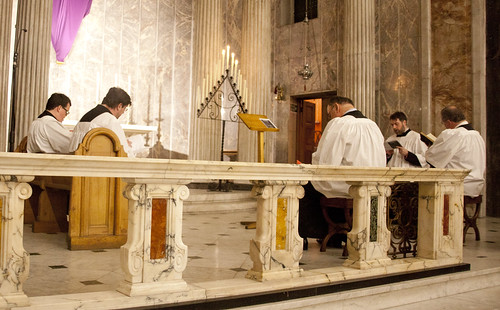
Pilgrimage to Caversham
Mass for this year's Ember Saturday pilgrimage to the restored Shrine of Our Lady of Caversham was celebrated by Fr Seth Phipps FSSP, and accompanied with chant and polyphony provided by the Schola Abelis of Oxford and the Newman Consort.
We had the full set of prophecies, which make the Ember Saturdays like little Easter Vigils.
With thanks to Mgr Patrick Daly the Parish Priest, and the parish in general for their hospitality.
Sponsorship scheme for embroidery training at the Royal School of Needlework
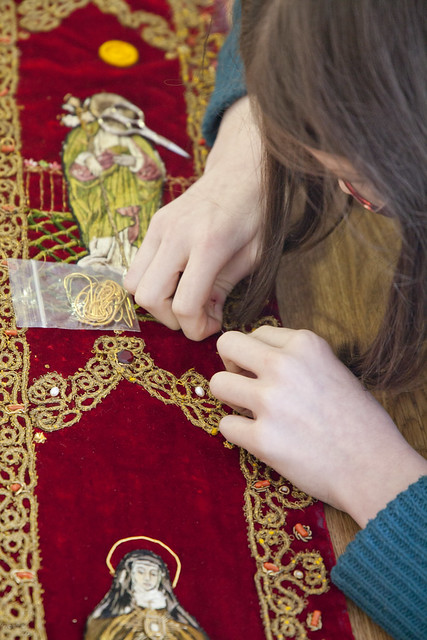 |
| Embroidery repair at the Guild of St Clare sewing retreat, Feb 2019 |
From the Latin Mass Society
The Guild of St Clare is launching a brand-new and very exciting initiative: the chance to study for the Certificate course at the Royal School of Needlework (RSN) at a subsidised rate of approximately 50%. The RSN Certificate Course is intended as a part-time course for keen amateurs and can readily be fitted around existing work and family commitments. It enables students to develop solid skills and become part of a long tradition of maintaining the highest standards in hand embroidery. More information about the course can be seen on the RSN website here.
Part of the mission of the Guild of St Clare is the teaching of skills essential to our work. We hope that in sponsoring places on the RSN Certificate Course we will be helping enthusiasts to gain the solid skills needed to repair, maintain, and create beautiful vestments and altar furnishings. Applicants should be able to demonstrate an enthusiasm for and commitment to hand embroidery and the restoration and creation of vestments. Further details about the sponsorship and how to apply can be found here.
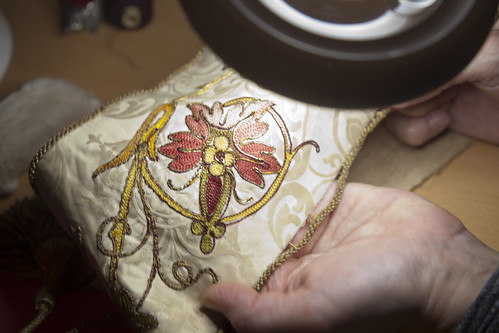 |
| At the Guild Vestment Mending Day in London, March 2019 |
New book by Martin Mosebach
 Angelico Press has brought out a new book, a collection of essays, by Martin Mosebach, author of the excellent book The Heresy of Formlessness.
Angelico Press has brought out a new book, a collection of essays, by Martin Mosebach, author of the excellent book The Heresy of Formlessness.
Amazon.co.uk has it here.
I was asked to write a blurb for it, here it is in full.
Martin Mosebach has once more demonstrated his ability to provide provocative insights into the condition of modern Catholicism in this collection of essays. He notes the tension between the liturgical principle, found in East and West, that the rites be "fear-inspiring", and the modern worshipper who "relaxes in an armchair waiting for [God] to arrive". He suggests that the needs of the ordinary believer are satisfied, if at all, in the kitsch products of Lourdes gift-shops, while elite Catholicism offers him an empty aesthetic puritanism. He suggests that the replacement of the monarch with the people, as the holder of sovereignty, makes for fiscal profligacy. He explores the parallel between the prayer wheels of oriental religions with the church bells of European Christianity. These essays are a tonic to our deep-rutted discourse on liturgy, spirituality, and religious sociology, refreshing, challenging, and setting us on new paths of thought.
Should the Pope apologise to Mexico?
A recent article of mine on LifeSite. It begins:
Priest attacked for wearing a clerical collar
A recent LifeSite article by me. It begins:
Cardinal Marx on Celibacy
A recent LifeSite article of mine. It begins:
Re re-print: the Parish Ritual
Cross-posted from Rorate Caeli.
Preserving Christian Publications has brought out a beautiful reprint of a book once almost as essential to the work of a priest as the Missal or Breviary: the Parish Ritual.
Published in the USA in 1962, it is the equivalent to the Small Ritual published in England in 1964. It is an extract from the Missal and the Roman Ritual, containing the texts needed by a priest for weddings, baptisms, and funerals, Extreme Unction, receptions of converts, and a large number of blessings (of Rosaries, the Miraculous Medal, Holy Water, etc. etc.), all in a handy format worthy of use in the liturgy itself.
One of the useful features of the book is that although all the Latin texts have a translation on the same page, a clear distinction is made between what, under the rules in force in 1962, must be said in Latin, and what can be said in English.
Preserving Christian Publications has not just scanned in an old copy. The whole book is reset, including the chants where applicable, bound in strong but flexible leatherette, with a reading ribbon and gilt pages, with good quality paper and rounded corners.
Even more important, they have replaced the Pian psalms with the ancient psalter wherever necessary. The Pian Psalter, created by Augusin (later, Cardinal) Bea, was a Latin translation of the Psalter in a supposedly more Classical Latin style. The whole idea was absurd, and unnecessarily distances the user from the words used by the Fathers and Doctors. It was criticised, implicitly, by the Second Vatican Council (for more on all this see here). But it was officially endorsed when it came out in 1945, and started appearing in liturgical books, though never made compulsory in the Office or the Roman Ritual.
 In my copy of the Small Ritual the older psalms are given as an option, in an appendix. This is obviously far from convenient, and Preserving Christian Publications has simply put them back into the main text.
In my copy of the Small Ritual the older psalms are given as an option, in an appendix. This is obviously far from convenient, and Preserving Christian Publications has simply put them back into the main text.
This book makes an ideal present for priests. If they are working outside the United States, they will need to be aware of US-specific customs in a few places, but notwithstanding that the book will be useful throughout the English-speaking world.
Since all priests have the right to use the blessings and sacramental forms in this book, it could even be of interest to a priest does does not yet celebrate the Traditional Mass, but would like to put a toe in the water with a legitimate alternative to the much-criticised post Vatican II 'Book of Blessings'.
You can buy it direct from the publishers here or from Amazon.com here.


